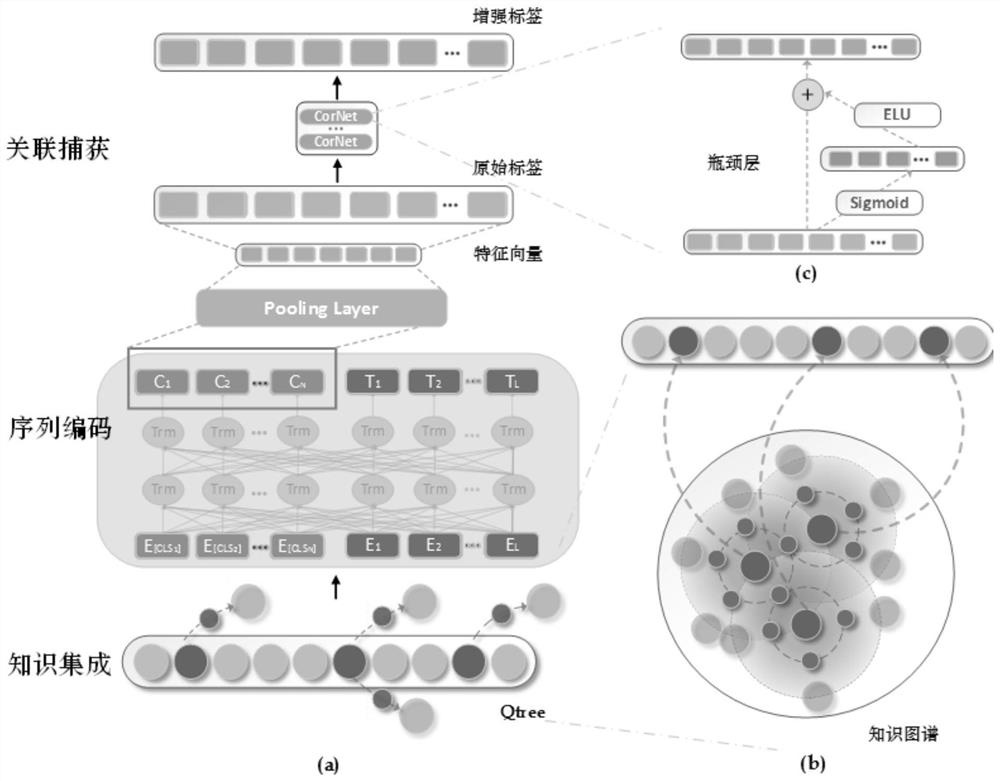Tag Recommendation Method for Online Question Answering Platform Based on Knowledge Graph and Tag Association
A technology of knowledge graph and recommendation method, applied in the fields of artificial intelligence, recommendation system, and natural language processing, can solve problems such as poor recommendation effect, achieve the effect of improving effect, alleviating long-tail problem, and enriching the form of expression
- Summary
- Abstract
- Description
- Claims
- Application Information
AI Technical Summary
Problems solved by technology
Method used
Image
Examples
specific Embodiment approach 1
[0015] Specific Embodiment 1: In this embodiment, the tag recommendation method of the online question-and-answer platform based on knowledge graph and tag association is as follows: input the question text and external knowledge graph of the online Q&A platform into the trained KOCIN model to obtain recommended tags.
[0016] The KOCIN model includes: a knowledge integration layer, a sequence encoding layer, and an association capture layer;
[0017] The knowledge integration layer is used to learn from the question text and external knowledge graph Extract the knowledge triples from the knowledge triples, and then integrate the knowledge triples into the question text to generate a sentence tree Qtree;
[0018] The sequence encoding layer adopts a sequence encoder based on BERT, which is used to convert Qtree into a dense vectorized representation of Qtree and then obtain the original label of the predicted question text;
[0019] The association capture layer includes: a ...
specific Embodiment approach 2
[0020] Specific implementation mode two: the knowledge integration layer is used to learn from the question text and external knowledge graph Extract the knowledge triples from the knowledge triples, and then integrate the knowledge triples into the question text to generate a sentence tree Qtree, including the following steps:
[0021] Step 11. For each entity e in the question text qi j Perform knowledge query to extract the set of knowledge triples. The specific process is:
[0022]
[0023] Among them, E={(e j ,r j1 ,e j1 ),...,(e j ,r jk ,e jk )} is the same as e j set of matched knowledge triples, r j1 is the entity e j The relationship with the first matched knowledge triplet, e j1 is the entity e j The entity of the first matched knowledge triplet, (e j ,r jk ,e jk ) is the kth knowledge triplet, and K_Query() is a query function;
[0024] Steps 1 and 2, insert all the knowledge triples in E into the corresponding positions in the question text qi, a...
specific Embodiment approach 3
[0028] Specific embodiment three: the sequence encoding layer adopts a sequence encoder based on BERT, which is used to convert Qtree into a dense vectorized representation of Qtree and then obtain the original label of the predicted question text, including the following steps:
[0029] Step 21, insert multiple [CLS] tags at the beginning of the Qtree obtained in steps 12:
[0030] Qtree_CLS={[CLS 1 ],...,[CLS c ],w 1 ,w 2 ,... e j {(r j1 ,e j1 ),...,(r jk ,e jk )},...,w n}
[0031] where c is the total number of [CLS] tags inserted and entity e j is the word wi matched to the knowledge triplet;
[0032] Step 22. Use Qtree_CLS to obtain the hidden state vector marked by [CLS], and then obtain the dense vectorized representation of Qtree according to the hidden state vector marked by [CLS]:
[0033] Using the method of dynamic maximum pooling, the information captured by multiple [CLS] is summarized, and a comprehensive feature vector u is generated:
[0034]
...
PUM
 Login to View More
Login to View More Abstract
Description
Claims
Application Information
 Login to View More
Login to View More - R&D
- Intellectual Property
- Life Sciences
- Materials
- Tech Scout
- Unparalleled Data Quality
- Higher Quality Content
- 60% Fewer Hallucinations
Browse by: Latest US Patents, China's latest patents, Technical Efficacy Thesaurus, Application Domain, Technology Topic, Popular Technical Reports.
© 2025 PatSnap. All rights reserved.Legal|Privacy policy|Modern Slavery Act Transparency Statement|Sitemap|About US| Contact US: help@patsnap.com



